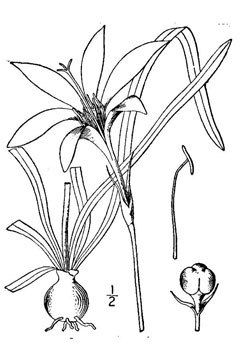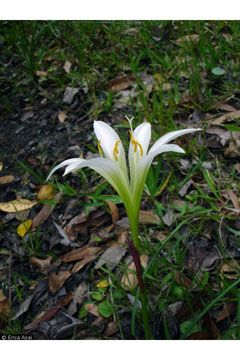 |
|
USDA-NRCS PLANTS Database / Britton, N.L., and A. Brown. 1913. An illustrated flora of the northern United States, Canada and the British Possessions. Vol. 1: 532 |
 |
| Erica Asai @ USDA-NRCS PLANTS Database |
Translate this page:
Summary
Physical Characteristics

 Zephyranthes atamasca is a BULB growing to 0.3 m (1ft) by 0.1 m (0ft 4in).
Zephyranthes atamasca is a BULB growing to 0.3 m (1ft) by 0.1 m (0ft 4in).
See above for USDA hardiness. It is hardy to UK zone 8. It is in flower from May to July, and the seeds ripen from April to June. The species is hermaphrodite (has both male and female organs) and is pollinated by Insects.
Suitable for: light (sandy), medium (loamy) and heavy (clay) soils and prefers well-drained soil. Suitable pH: mildly acid, neutral and basic (mildly alkaline) soils. It cannot grow in the shade. It prefers moist soil.
UK Hardiness Map
US Hardiness Map
Synonyms
Plant Habitats
Cultivated Beds; East Wall. By. South Wall. By.
Edible Uses
Edible Parts: Root
Edible Uses:
Bulb - cooked[2, 22, 46, 61]. It is used as an emergency food when better foods are in short supply[61, 161]. The bulb is up to 3cm long[235]. Caution is advised, see the notes above on toxicity.
References More on Edible Uses
Medicinal Uses
Plants For A Future can not take any responsibility for any adverse effects from the use of plants. Always seek advice from a professional before using a plant medicinally.
None known
References More on Medicinal Uses
The Bookshop: Edible Plant Books
Our Latest books on Perennial Plants For Food Forests and Permaculture Gardens in paperback or digital formats.

Edible Tropical Plants
Food Forest Plants for Hotter Conditions: 250+ Plants For Tropical Food Forests & Permaculture Gardens.
More

Edible Temperate Plants
Plants for Your Food Forest: 500 Plants for Temperate Food Forests & Permaculture Gardens.
More

More Books
PFAF have eight books available in paperback and digital formats. Browse the shop for more information.
Shop Now
Other Uses
References More on Other Uses
Cultivation details
Requires a position in full sun when grown outdoors in Britain and a well-drained moisture retentive soil[1, 42, 200]. It strongly dislikes excessive wet, especially in the winter[200]. Plants require a definite dry resting period in late summer, if they receive water at this time they are excited into growth and can then be killed in cold weather[120]. A very ornamental plant[1], it is hardy to about -5°c and can succeed outdoors in the milder areas of Britain[200]. However, because it is in growth during the winter, it is generally best grown in a cold greenhouse or special bulb frame[K]. Bulbs should be planted about 10cm deep[200].
References Carbon Farming Information and Carbon Sequestration Information
Temperature Converter
Type a value in the Celsius field to convert the value to Fahrenheit:
Fahrenheit:
The PFAF Bookshop
Plants For A Future have a number of books available in paperback and digital form. Book titles include Edible Plants, Edible Perennials, Edible Trees,Edible Shrubs, Woodland Gardening, and Temperate Food Forest Plants. Our new book is Food Forest Plants For Hotter Conditions (Tropical and Sub-Tropical).
Shop Now
Plant Propagation
Seed - sow spring in a greenhouse. Sow the seed thinly so that the seedlings can be left undisturbed in the pot for their first year of growth. Give them an occasional liquid feed in the growing season to ensure they do not become nutrient deficient. When the plants become dormant in the summer, pot up the small bulbs placing 2 - 3 bulbs in each pot. Grow them on for another one or two years in the greenhouse before planting them out when they are dormant in late summer. Division of offsets after the plant dies down in late spring or early summer. Larger bulbs can be planted out direct into their permanent positions whilst it is best to pot up the smaller bulbs and grow them on in the greenhouse for a year before planting them out.
Other Names
If available other names are mentioned here
Native Range
NORTHERN AMERICA: United States (Alabama, Florida, Georgia, North Carolina, South Carolina, Virginia (east), Mississippi (southeast)).
Weed Potential
Right plant wrong place. We are currently updating this section.
Please note that a plant may be invasive in one area but may not in your area so it's worth checking.
Conservation Status
IUCN Red List of Threatened Plants Status :

Growth: S = slow M = medium F = fast. Soil: L = light (sandy) M = medium H = heavy (clay). pH: A = acid N = neutral B = basic (alkaline). Shade: F = full shade S = semi-shade N = no shade. Moisture: D = dry M = Moist We = wet Wa = water.
Now available:
Food Forest Plants for Mediterranean Conditions
350+ Perennial Plants For Mediterranean and Drier Food Forests and Permaculture Gardens.
[Paperback and eBook]
This is the third in Plants For A Future's series of plant guides for food forests tailored to
specific climate zones. Following volumes on temperate and tropical ecosystems, this book focuses
on species suited to Mediterranean conditions—regions with hot, dry summers and cool, wet winters,
often facing the added challenge of climate change.
Read More
Expert comment
Author
(L.)Herb.
Botanical References
43200270
Links / References
For a list of references used on this page please go here
Readers comment
| Add a comment |
|
If you have important information about this plant that may help other users please add a comment or link below. Only comments or links that are felt to be directly relevant to a plant will be included. If you think a comment/link or information contained on this page is inaccurate or misleading we would welcome your feedback at [email protected]. If you have questions about a plant please use the Forum on this website as we do not have the resources to answer questions ourselves.
* Please note: the comments by website users are not necessarily those held by PFAF and may give misleading or inaccurate information.
To leave a comment please Register or login here All comments need to be approved so will not appear immediately.
|
Subject : Zephyranthes atamasca
|
|
|
|